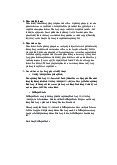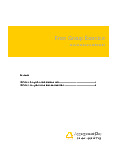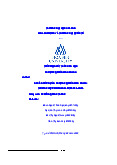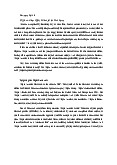








Preview text:
CASE 22 Diet Sweet Candy Company
Wi l li am G im pe l , pr e si de nt o f t h e D i et S w ee t Ca nd y Company, is
considering the possibility of expanding his company's distribution into the
drugstore field. The company, the world's largest producer of dietetic sweets and
biscuits, has achieved its principal distribution through the candy departments
in department stores, variety stores, and other general-merchandise retailers
Through Gimpel's efforts the company has also achieved substantial inroads in the
supermarket and specialty-food fields. Although some of Diet Sweet's products have
found their way onto the shelves of drugstores through distributors, the firm has not
made any conscientious effort to achieve distribution through these outlets.
The Diet Sweet product line
The Diet Sweet Candy Company sells four separate categories of products: (1)
consumer packaged dietetic sweets and biscuits sold under the Diet Sweet brand; (2)
consumer packaged and bulk sales of dietetic sweets sold under private labels of a
few leading retailers; (3) dietetic seasonal items such as for Valentine's Day; and (4)
a line of imported European chocolates that are nondietetic.
Dietetic sweets are made without sugar, salt, corn syrup, or artificial sweetners. In
their place, mannitol and sorbitol, the natural, sweet nutritive ingredients found in
many fruits and edible berries, are used. Mannitol and sorbitol are not sugars in a
chemical sense. Mannitol is metabolically inert because it does not change into
sugar in the body in any appreciable amount. Sorbitol can be converted into
glucose and fructose, but only in trace amounts considered to be clinically trivial, a
conversion that is also true of a great many other organic compounds, such as
proteins, which are not considered to be sugars. As a precursor to sugar, sorbitol
sugar contribution would be negligible, even if substan tial amounts were consumed.
Neither sorbitol nor!mannitol is harmful to diabetics, since mannitol has little
effect on body metabolism, and sorbitol, insofar it has an effect, would not be harmful.
In addition to the metabolic considerations, dietetic sweets have a psychological
advantage from the standpoint of the diabetic patient. Dietetic sweets provide a
break from the monotony of the diabetic's diet without putting an intolerable
pressure on the body mechanism. For similar reasons, most physicians recommend
dietetic sweets for those afflicted with hypoglycemia. A survey done on behalf of the
Diet Sweet Candy company reported that four out of five dentists also recom -
mended sugarless sweets, since sorbitol and mannitol are considered
noncariogenic. Besides being on firm ground medically, Diet Sweet products
compare favorably in quality taste and appearance with the finest sugar sweets—
hence diabetic or other patients are less inclined to stray from their diets.
The nature of any candy or food product creates special problems concerning their
handling, shipping, and display. A special effort must be made by the middleman to
preserve their salability. Chocolates, or items containing chocolate, require storage
at a temperature of 65° Fahrenheit or lower to prevent melting or discoloration. This
means that chocolates must be kept under refrigeration or at least in air-conditioned
surroundings while in transit, at the distributor, and at the retail store during warm
weather. Many of Diet Sweet's products, particularly chocolates and biscuits, are
susceptible to odors that will affect taste; As a consequence, these products further
require that they not be stored or transported in any surroundings having pungent
odors. Humidity is another factor that must be considered in dealing with candy
products. Finally, insect infestation creates a special problem in dealing with candy.
Diet Sweet takes extreme preventative care to guard against infestation, since all
products are manufactured under sanitary, highly automated conditions. Infestation
sometimes does occur in distribution if the Diet Sweet products are stored or
displayed near other infested products. Infestation and other problems associated
with the marketing of candy have been of great concern to the Diet Sweet
Company, since the consumer will not tolerate such merchandise. The company
faces the problem of generally having very little control, except through its
middlemen, on the resale of its products. As one measure to encourage immediate
action to prevent infestation, Diet Sweet would only give a retail or wholesale
customer a one-time credit on infested merchandise, since it would be the
customer's responsibility to clear up the source of the infestation. If Diet Sweet
could determine that customer neglect was the cause of the infestation, then no
credit on returned merchandise would be extended. Distribution channels
Gimpel takes special pride in the fact that Diet Sweet products are easily obtainable
throughout the country and that an estimated 30 million persons purchase their
products. The original pattern of distribution for the company was established
through leading department stores across the nation, which have remained the
principal outlets for the sale of Diet Sweet products. These retailers often order the
products directly or through their resident buying offices in New York if they
merchandise under their own private brands. Alternatively, a number of stores have
been sold the products through agent middlemen who call on these accounts.
Since department stores typically operate large candy departments, and often in a
number of branch stores, these retailers easily obtained large discounts when
buying in quantity. Diet Sweet occasionally would send out letters, on each
department store's letterhead, to all doctors and dentists in the trading area,
describing the health benefits of Diet Sweet products. From this foundation Diet
Sweet easily extended distribution through variety stores and large general-
merchandise chains such as Sears and J. C. Penney. Diet Sweet has become nationally
authorized by the central offices of the major variety and general-merchandise
chains. The firm received its orders from these chains routed through the chain
warehouses or, in some cases, directly from the individual store managers.
Diet Sweet has also been successful in obtaining distribution for its products
among some 5,000 candy, nut, and confectionery stores. Except for the large
candy store chains such as Russell Stover, which buys direct, these retailers were
sold products through the same manufacturers' agents who called on department
stores and other general-merchandise retailers. Through these same agents Diet
Sweet has obtained some distribution in gift shops and stationery stores. The gift
shops, cart services, and dietary kitchens in hospitals have also been a source of
some business for the company. This business was handled either directly, or
through an agent in the case of the gift shops. Similarly, the company has
obtained some distribtition for its products through military post exchanges and commissa ries.
The company has also maintained a thriving mail-order business. Ani7
interested customer is able to write directly to the company for a mail-order
catalog and buy his personal requirements. A minimum $4 order is required for this
service. Also handled directly are orders from schools, scout troops, civic clubs, and
so on. These organizations are allowed to order at wholesale prices in order to resell
at retail prices as a means of fund raising. Special prices and minimum shipment
offers have been made available to doctors and dentists for use with their
patients for goodwill purposes. Finally, Diet Sweet has sold either directly or
through distributors and agents to a variety of institutional accounts, such as health
and reducing clubs, beauty parlors, motels and hotels, and athletic and university
organizations. The products can be sent to the outlets prepriced, with the price
printed on the package, or unpriced, depending on the wishes of the particular outlet.
After Gimpel assumed the presidency of the company in 1964, he launched the
company on its first major effort to cultivate the sale of dietetic sweets in
supermarkets and among specialty-food retailers. As a consequence, Diet Sweet
products are merchandised by every major food chain in the United States and
Canada. Diet Sweet products are attractive to the food retailer because of the high,
direct product profits per linear foot of shelf space. Candy in general provides the
food retailer with a 27 percent gross profit margin, the seventh highest-ranking
product category in the typical food store. Diet Sweet products, which are shelf-
stocked, prepriced, and guaranteed exchange on any shelf- worn merchandise,
yield the food-store operator a 33 percent direct product profit. The success of the
company in obtaining supermarket distribution for its products has largely been
attributable to three distinct aspects of Gimpel's strategy to obtain distribution in
food stores. In the first place, the company undertook an extensive campaign of
national advertising with full-color advertisements in McCall's, Good Housekeeping,
Redbook, Sunset, Southern Living, Ladies Home Journal, Family Circle, and Woman's
Day. Diet Sweet products have also been featured as prizes on two national
television network daytime shows, NBC's "Sale of the Century," and ABC's
"Let's Make a Deal." The company then promoted its consumer advertising to the
food retailer through color advertise ments in Progressive Grocer and other trade
publications. To merchandise its products to the retailer effectively the Diet
Sweet Candy Company promoted four separate supermarket sales programs.
One program involved a 12-foot shelf program that would cost the retailer
$209.30 and sold for $308.64. It included an assortment of candies, gum,
wafers, and cookies. The company also promoted an 8-foot shelf program
costing $118.36, retailing for $175.20, or a profit of $56.84. The emphasis in
this program was on cookies, wafers, and mints. A third sales program
involved a store investment of $159.36, with a retail value of $237.68, thereby
generating a profit of $78.32. This program included the offer of a freestanding
floor stand, measuring 25 inches wide by 14 inches deep by 60 inches tall. (See
Table 1 for a description of the merchandise included with the display rack.)
The fourth sales program provided the retailer with a counter display rack
measuring 23 inches long by 12 inches high and deep. The inventory investment
required in dietetic bar candies, gum, and mints amounted to $31.21. It would
sell for $46.40, or a profit of $15.19.
Diet Sweet has established three distinct channels of distributions for reaching
food chains and independent retailers affiliated with a food wholesaler. The
most commonly used method is to enlist the services of a truck jobber to service
each individual food store in a given geographic area. It is his responsibility to
make deliveries directly to the stores, to see to it that shelves are restocked, and to
service all Diet Sweet displays in a particular store. The truck jobber receives his
compensation by buying at the wholesale price, less a 2.0 percent trade discount
for his services. Gimpel believes that the truck jobbers for biscuits and snack
foods are the most desirable distributors for handling Diet Sweet products in
food stores and that these middlemen offer the most professional services. In
market areas, where Diet Sweet has not been able to obtain the services of truck
jobbers, the company sometimes relies on the services of rack jobbers in the area
of health and beauty aids to provide the same service.
Another approach to obtain supermarket distribution is to rely on an established
food broker to service accounts. In these instances the food chain buys through
the food broker for its central warehouses. The chain then distributes the
products from the warehouse to their individual stores. The broker follows up
by seeing that adequate shelf facings and displays are given to Diet Sweet
products. Brokers are compensated with a 3 percent commission for their
services. Brokers have the options
TABLE 1Merchandise assortment of diet sweet candy on freestanding display unit QuantitySuggested Tota l co st To tal r et ai l packaged retailDescription 2/1 $0.69 Fruit gumdrops $11.0 $16.56 1/2 0 15 Peppermint hard 2 40 3 60 1/2 0 15 Sour-cherry hard 2 40 3 60 1/2 0 15 Sour-lemon hard 2 40 3 60 1/2 0 15 Cough hard candies 2 40 3 60 2/1 0.49 Assorted hard 8.00 11.76 1/1 0.49 Licorice hard 4.00 5.88 1/1 0 79 Assorted hard 6 52 9 48 1/2 0 15 Bittersweet 2 40 3 60 1/2 0 15 Milk chocolate bars 2 40 3 60 1/2 0 15 Coconut chocolate 2 40 3 60 1/2 0.15 Almond chocolate 2.40 3.60 1/2 0 15 Peppermint 2 40 3 60 1/2 0 35 Bittersweet 5 60 8 40 1/2 0 35 Milk chocolate bars 5 60 8 40 1/2 0.35 Almond chocolate 5.60 8.40 1/1 1 00 Milk assortment 8.00 12.00 1/1 0 69 Peanut butter cups 5 52 8 28 1/1 1 25 Petit fours 10 00 15 00 1/1 0 59 Chocolate-covered 4 80 7 08 1/1 0 69 TV mix 5 52 8 28 4/2 0.10 Peppermint gum 5.32 8.00 4/2 0 10 Spearmint gum 5 32 8 00 2/2 0 10 Fruit gum 2 66 4 00 2/2 0 10 Peppermint mints 2 66 4 00 1/2 0 10 Sour-lemon mints 1 33 aoo 1/2 0.10 Sour-orange mints 1.33 2.00 2/2 0 10 Sour-cherry mints 2 66 4 00 1/2 0 10 Butterscotch mints 1 33 2 00 1/2 0 10 Chocolate mints 1 33 2 00 2/2 0 10 Spearmint mints 2 66 4 00 2/2 0.10 Wintergreen mints 2.66 4.00 6/2 0.05 Bubble gum 5.10 7.20 1/1 0 49 Assorted filled 4 00 5 88 2/2 0 15 Bittersweet wafers 4 80 7 20 2/2 0 15 Milk wafer 4 80 7 20 $159.3 $237.6
of working alone or through a wholesaler or a truck jobber. If they elect to use a
jobber or distributor, Diet Sweet reserves the right to approve the arrangement
first through its home office or the regional sales manager. Finally, it is also
possible for individual store managers to place orders directly with Diet Sweet's home
office and have the merchandise shipped to them directly.
Specialty-food stores, which include delicatessens, bakeries, and health-food
shops, are normally sold the products in the same manner as are supermarkets or
candy stores and department stores, depending on the size and scope of their
operations. In states permitting such arrangements, Diet Sweet products are
sometimes sold through liquor stores. In reaching liquor stores, the Diet Sweet
company first determined which distributors served these retailers with
nonalcoholic items, and sales were then made through these middlemen.
In order to exercise some control over the myriad of middlemen that Diet Sweet
utilizes in reaching the market, the company has divided its national market into six
geographical areas, each of which is under the supervision of a regional sales
manager living in that area. One sales manager is responsible for the
metropolitan New York City area. Another has responsibility for New York
State, New England, and eastern Canada. Other managers are assigned the
Middle Atlantic and South Atlantic states; the South Central states; the Midwest;
and the West Coast, Hawaii, and Alaska. Generally, these sales managers act as
missionary or supporting salespeople, since the actual order taking is performed
by the various middlemen employed.
One important task of the regional sales managers is to arrange regularly
scheduled meetings between themselves and the distriburors and agents in their
geographic areas. These meetings are supposed to keep the distributors and
agents up to date on changes in Diet Sweet products and policies, and to sell the
middlemen on the quality and popularity of Diet Sweet products, which would
hopefully lead them to devote more of their time and effort to promoting Diet Sweet
business. Finally, these meetings are used to train the distributors in selling,
displaying, and handling Diet Sweet products.
The major alternative to the variety of channels of distribution that Diet Sweet
utilizes, according to Gimpel, is to follow the lead of most candy manufacturers
and to appoint a candy jobber in a particular market and assign all kinds of retail
outlets to him. The candy jobber would be the only kind of middleman who would
have the capability to deal with a product having restrictive distribution elements
(as mentioned earlier, affinity to odors, infestation by vermin, sensitivity to
temperature and humidity change). The preference for utilizing a wide variety of
middlemen instead of only utilizing the services of candy jobbers is based on
Gimpel's belief that market saturation can best be achieved by using middlemen
who concentrate on specialized lines of trade. He views the activities of candy
jobbers as primarily calling on buyers and soliciting orders as being inadequate for
Diet Sweet's needs. Gimpel desires that his middlemen representatives be retail
oriented in the sense that they would assume the responsibility for Diet Sweet
displays week-in and week-out in all stores of customers for which they are
responsible. In contrast he views candy brokers as being unable to service
retail displays—a central theme in Diet Sweet's distribution strategy. To achieve
this type of market saturation and display effort Gimpel realizes he has been
incurring higher distribution costs. The reduction in expenses offered by the
services of the candy broker in reducing administrative paper work is considered
a minor consequence compared with the ability of the present distributive
structure to merchandise effectively in a variety of specialized lines of retail trade.
The physical-distribution process
In the physical-distribution process, Diet Sweet products are first moved from the
plant located in New York City to the warehouse in nearby New Jersey, which is the
distribution center for the East Coast. Products going to the West Coast or the
Midwest are then shipped to the warehouse in Chicago. From the warehouses the
products are shipped either to the distributor's warehouse or, if handled by a
broker alone, to the retail outlet. Shipments are made by truck, air freight, parcel
post, Railway Express, or United Parcel. The method used in transporting the goods
is determined by three factors: (1) the importance of speed in transporta tion, (2)
the distance involved, and (3) the cost involved. Diet Sweet products that are
imported from other countries, such as the Nether lands and Finland, come directly
to one of the two company warehouses. One exception to the distribution process is
that retail outlets in the New York metropolitan area are serviced by off-truck
jobbers directly from the New Jersey warehouse rather than going through the middleman structure. Conditions of sale
In dealing with accounts with which satisfactory credit ratings have been established,
the terms of sale are 1 percent, 10 days, net 30 days. Time periods are calculated
from the date of shipment, which is recorded on the invoice. Discounts are offered as follows:
1.RETAIL PRICE LIST. All retail accounts wishing to purchase directly may do
so from this price list. The prices are the same as those at which the
distributors normally sell. Shipments of $60 or more net are prepaid, whereas
any shipment of less than $60 requires an additional charge of $3 to cover
postage and handling. A 10 percent trade discount is given for shipments of $135 (net) or more.
2.WHOLESALE PRICE LIST. This is made available to all customers who order
quantities by the full case. Prices listed on this sheet are subject to a 20 percent
discount, and shipments of $250 (net) or more are prepaid.
Shipments to Alaska, Hawaii, and U.S. possessions are subject to the same terms
but are shipped f.o.b. For continental United States, all orders for shipment
received at the New Jersey warehouse by telephone or mail by 11 A.M. on any
business day are invoiced immediately through data processing and, barring any
problem, are shipped out on the same day.
During warm weather, satisfactory service on reefer trucks is only available on
certain days, but in such instances all parties concerned are advised accordingly. The
original copy of the invoice—with the name of the carrier, date of shipment,
number of cartons in the shipment, and a copy of the signed bill of lading—is
mailed to the customer by first-class mail the day after shipment is made.
Credit on returned merchandise
Under three sets of circumstances, Diet Sweet will not extend credit for returned merchandise:
1.If the product is over two years old. (All products are date-coded for use in determining their age.)
2.If merchandise is infested or otherwise unsalable due to customer neglect.
3.If the product is an open-faced or seasonal item.
If these conditions do not prevail, then the retailer must submit a request to
return merchandise with Diet Sweet's sales service depart ment, and if the request
is in order, an authorization for return will be issued. The customer must then
return just the empty package or wrapper of the product to the New Jersey
warehouse. Credit memos will then be processed, usually within one week of the
receipt of the wrappers or empty packages. There are two basic credit policies, each
applicable to specific categories of trade:
1.Credit on sales to supermarkets, truck jobbers, department stores, variety stores,
candy stores, hospitals, gift shops, specialty-food stores, and the military is
extended at full customer cost for in-store spoils, except for reasons previously
mentioned. Credit will be given only once for infestations because it is the
customer's responsibility to clear up the cause of the infestation. If seasonal items
are overstocked and then returned, only 30 percent credit will be given.
2.All accounts in the categories of discount stores, candy jobbers, and
miscellaneous sales will be extended credit at 50 percent of customer's cost on
all returns. This is because Diet Sweet generally has little control over the product
merchandising, quantity, location, and type of display in these outlets. Credit and collections
Credit is extended on all sales to retail outlets by Diet Sweet. Past-due items in
excess of $300 are followed up by the main office or their brokers by a series of
three letters, attached to which is the statement. The first letter is for invoices 35 to
44 days old; the second, invoices 45 to 54 days old; and the third, for invoices 55 to
65 days old. The third letter indicates that a sight draft will be drawn on the customer.
Accounts over 65 days in arrears are subject to placement with a collection
agency. If this occurs, the commission previously paid to the broker is charged
against his account. This encourages the broker to keep an eye on his accounts
so that their bills do not become overdue.
Distribution planning for the drugstore market
Gimpel is earnestly interested in expanding the sales of Diet Sweet products
into the drugstore field. Although some of the brand's prod- ucts had been placed
on drugstore shelves by enterprising distributors, the firm had not made any real
effort to cultivate this market. With over 50,000 drugstores in the country, the
drugstore market offers a real market opportunity for Diet Sweet. Gimpel realizes
that most drugstores received their ten-cent candy from candy-tobacco wholesalers.
Boxed candy is typically obtained from tobacco wholesalers. Boxed candy is
typically obtained from candy jobbers who specialize in that line of business. It is
Gimpel's observation that drug wholesalers would only be good for running an "in
and out" special promotion or for stocking only those items on which an automatic
continuous demand could be established. He further feels that large drugstore
chains might be a prime target for his firm's marketing activities. A complete
merchandise sales program might be established with the headquarter
merchandising managers of these chains. If a chain has only a small number of
stores, a limited line of the best-selling dietetic sweets could be stocked by all
stores and sold by drug brokers through the chain warehouses. In larger chain
operations, distribution could be handled on a drop-shipment basis or possibly
by using a supermarket truck jobber in those markets where they are in a position to
extend the same kind of shelf-stocking service to the drugstores that they extend to the supermarkets. Questions
1.How would you evaluate Diet Sweet's distribution policies?
2.What problems would you anticipate in expanding Diet Sweet's distribution into drugstores?




